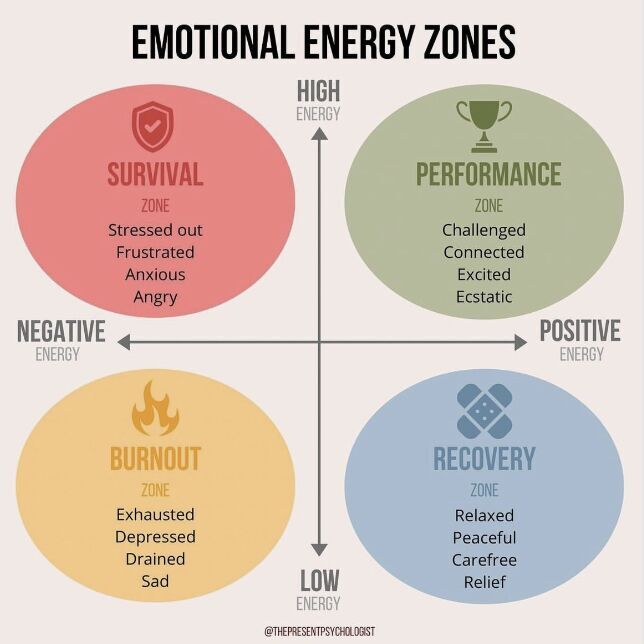Introduction
Embarking on the intricate journey of life, our emotional energy zones play a profound role, akin to the ebbs and flows of a vast emotional landscape. This article explores the dynamic concept of emotional energy zones, encompassing the spectrum from high-energy positivity to low-energy negativity, and offers insights into effective management for holistic well-being.
Understanding the spectrum
Emotional energy zones span from high-energy positivity to low-energy negativity, dictating our emotional well-being. At the high-energy end, positive emotions fuel enthusiasm and resilience, contributing to an optimal state for survival and performance. Conversely, low-energy negativity may lead to burnout, affecting decision-making, productivity, and relationships.
Identifying your Emotional Energy Zones
The first step towards effective management lies in self-awareness. Recognising one’s current emotional energy zone involves a mindful exploration of mood, physical sensations, and thought patterns. Whether riding the waves of high-energy positivity or navigating the depths of low-energy negativity, understanding these indicators empowers individuals to navigate their emotions.
The impact of emotional energy on daily life
When individuals experience high-energy positivity, it serves as a powerful catalyst for numerous positive outcomes in their daily pursuits. This heightened emotional state fuels creativity, enabling individuals to approach challenges with innovative solutions and think outside the conventional boundaries. It enhances focus, allowing for a more concentrated and efficient approach to tasks and responsibilities. The positive emotional energy becomes a driving force behind optimal performance, creating a conducive environment for success in both personal and professional endeavours.
On the downside, prolonged exposure to stress and adversity can trigger a shift towards low-energy negativity, significantly impacting daily life. This negative emotional state, if left unaddressed, can lead to burnout, a state characterised by chronic exhaustion, cynicism, and reduced professional efficacy. The consequences of burnout extend beyond the workplace, affecting decision-making abilities and overall productivity in various life domains.
In daily life, the impact of emotional energy is evident in decision-making processes. High-energy positivity facilitates clearer thinking and more informed decision-making, while low-energy negativity can cloud judgment and lead to impulsive or suboptimal choices. Relationships, both personal and professional, are deeply influenced by the emotional energy individuals bring into interactions. Positive emotional energy fosters harmonious relationships, effective communication, and a supportive environment. On the contrary, low-energy negativity may lead to interpersonal conflicts, strained communication, and a negative atmosphere.
Physical health is also intertwined with emotional energy. High-energy states contribute to overall well-being, promoting vitality and resilience. Conversely, the manifestation of low-energy negativity can manifest physically, leading to issues such as chronic fatigue, disrupted sleep patterns, and susceptibility to illnesses.
The impact of emotional energy on daily life is essentially pervasive and multi-faceted. It affects cognitive functions, decision-making processes, relationships, and physical well-being. Recognising this influence underscores the importance of actively managing emotional energy to cultivate a positive and sustainable foundation for navigating the complexities of daily life. Employing strategies to maintain high-energy positivity and addressing sources of stress can lead to a more fulfilling and successful daily experience.
Strategies for managing emotional energy
Effectively managing emotional energy involves a comprehensive and intentional approach that encompasses various strategies to promote positive emotions and prevent burnout. Mindfulness practices play a pivotal role in this endeavour. Incorporating mindfulness into daily routines, such as meditation or deep-breathing exercises, allows individuals to cultivate awareness of their emotions. This heightened awareness enables better regulation of emotional responses, fostering a positive emotional energy state.
Practising gratitude is another powerful strategy for managing emotional energy. Regularly expressing gratitude for positive aspects of life, whether big or small, contributes to a positive mindset. This can be achieved through keeping a gratitude journal, where individuals jot down things they are thankful for each day. Engaging in this practice shifts focus towards positive experiences, enhancing overall emotional well-being and maintaining high-energy states.
Recognising signs of low-energy negativity is crucial for effective emotional energy management. This involves self-awareness and an understanding of personal triggers that may lead to emotional depletion. When signs of negativity arise, implementing recovery strategies becomes paramount. This could include taking short breaks to engage in activities that bring joy, seeking support from friends or colleagues, or practising relaxation techniques. Creating a personalised toolkit of recovery strategies empowers individuals to navigate challenging emotional states effectively.
Setting realistic boundaries is another practical strategy for managing emotional energy. This involves knowing one’s limits and communicating effectively to prevent overwhelming situations. Learning to say ‘no’ when necessary, delegating tasks, and prioritising self-care contribute to maintaining a healthy balance of emotional energy. By respecting personal boundaries, individuals can proactively prevent burnout and foster long-term emotional resilience.
Practical advice for implementing these strategies includes dedicating specific times for mindfulness or gratitude practices each day, keeping a gratitude journal, and actively monitoring emotional states for signs of negativity. Creating a personalised plan for recovery, including activities that bring joy and seeking support when needed, adds a practical dimension to emotional energy management. Establishing clear communication about boundaries in personal and professional relationships ensures a sustainable balance in emotional well-being.
Cultivating a positive emotional energy environment
Creating a positive emotional energy environment involves deliberate actions and considerations within various facets of life. In the context of social connections, fostering meaningful relationships is subsequently paramount. Actively engage with friends, family, and colleagues who uplift and support you. Cultivate an environment where open communication and emotional sharing are encouraged, enabling the exchange of positive energy.
Supportive relationships play a pivotal role in shaping emotional well-being. Surround yourself with individuals who provide encouragement, empathy, and constructive feedback. Actively seek out opportunities to connect with others, whether through social events, shared hobbies, or collaborative projects. Regular interaction with supportive individuals fosters a sense of belonging and strengthens the emotional foundation.
In the workplace, a positive emotional energy environment can be cultivated through mindful leadership and a supportive team culture. Leaders should encourage open communication, acknowledge achievements, and provide constructive feedback. Team members, in turn, can contribute by fostering a collaborative and inclusive atmosphere, where mutual respect and appreciation prevail. Simple acts of kindness, such as expressing gratitude or offering assistance, contribute to a positive workplace environment.
Establishing boundaries is crucial for maintaining a positive emotional energy balance. Learn to recognise and communicate your limits effectively. This might involve setting aside time for self-care, clearly communicating expectations in personal and professional relationships, and knowing when to delegate tasks or seek assistance. By respecting your boundaries, you contribute to a healthier emotional environment for yourself and those around you.
Practical hands-on advice may include scheduling regular social activities, both in and outside the workplace, to nurture connections. Practice active listening and empathy in your interactions, allowing for authentic and meaningful connections. Additionally, incorporate moments of joy into daily routines, whether it’s through small celebrations of achievements, engaging in hobbies, or taking short breaks to recharge.
Survival, performance, burnout, and recovery
Survival instincts are innate responses that propel individuals into high-energy states, crucial for effectively navigating challenging situations. In times of stress, these instincts activate the body’s fight-or-flight response, enabling individuals to cope and adapt. However, the sustained activation of survival instincts can have adverse effects, leading to a state of burnout. Burnout is characterised by a depletion of energy and a pervasive sense of negativity, impacting both mental and physical well-being.
Signs and symptoms of burnout may manifest in various ways:
- Emotionally, individuals experiencing burnout may feel a persistent sense of exhaustion, detachment, and a decline in their ability to find joy in activities they once enjoyed.
- Physically, symptoms can include chronic fatigue, changes in sleep patterns, and even physical ailments like headaches or gastrointestinal issues.
- Cognitively, burnout may manifest as difficulty concentrating, reduced productivity, and a heightened sense of cynicism or negativity towards work and life in general.
Recognising these signs is crucial for initiating the recovery process. This involves acknowledging the need for a shift from survival and burnout states towards a balanced, positive emotional state conducive to optimal performance. Recovery strategies may include implementing regular breaks, engaging in activities that bring joy and relaxation, seeking support from colleagues or professionals, and practising mindfulness techniques. For example, taking short walks during work breaks, participating in hobbies, and incorporating mindfulness meditation into daily routines are tangible steps towards recovery.
The role of recovery in emotional well-being
Emotional recovery is a dynamic process crucial for replenishing high-energy states and maintaining a healthy mental equilibrium. To actively engage in this process, individuals can implement hands-on strategies:
- Incorporating activities that evoke joy and relaxation is essential. This could involve identifying personal hobbies or interests that bring a genuine sense of pleasure. Whether it is reading, creative pursuits, or outdoor activities, these moments of enjoyment contribute significantly to emotional recovery.
- Seeking support is a vital aspect of the recovery journey. Establishing a network of trusted individuals, be it friends, family, or professional therapists, provides a valuable outlet for emotional expression. Sharing thoughts and feelings in a supportive environment fosters a sense of connection and aids in the processing of emotions.
- Integrating mindfulness practices into daily life can be transformative. Mindfulness techniques, such as meditation or deep-breathing exercises, help individuals cultivate awareness of their emotions and promote a sense of inner calm. Consistent practice of mindfulness can enhance emotional resilience over time.
- It is crucial to recognise the importance of self-care. This involves prioritising one’s well-being by ensuring adequate rest, proper nutrition, and regular exercise. Taking care of physical health positively influences emotional states, contributing to an overall sense of balance.
By actively incorporating these hands-on strategies into daily life, individuals can proactively contribute to their emotional recovery, fostering resilience and cultivating a positive emotional state.
Conclusion
The exploration of emotional energy zones reveals a profound interplay between our internal states and the external landscape of daily life. Understanding the spectrum from high-energy positivity to low-energy negativity is the first step towards effective management for holistic well-being.
The impact of emotional energy on decision-making, relationships, and physical health is undeniable. High-energy positivity becomes a catalyst for creativity, focus, and optimal performance, while prolonged exposure to low-energy negativity can lead to burnout with far-reaching consequences.
Strategies for managing emotional energy offer a comprehensive approach, with mindfulness, gratitude practices, and setting realistic boundaries playing pivotal roles. Recognising signs of low-energy negativity and implementing recovery strategies become crucial elements in this journey.
Cultivating a positive emotional energy environment involves deliberate actions in social connections and the workplace. Meaningful relationships and supportive team cultures contribute significantly to emotional well-being. Establishing and respecting boundaries is key to maintaining a positive balance.
Survival instincts, essential for navigating challenges, can lead to burnout if sustained. Recognising the signs of burnout prompts the need for recovery strategies, including breaks, joyful activities, and seeking support.
Emotional recovery is a dynamic process, requiring the incorporation of activities that evoke joy, seeking support, integrating mindfulness practices, and prioritising self-care. By actively engaging in these strategies, individuals can contribute to their emotional recovery, fostering resilience and cultivating a positive emotional state for a fulfilling and successful daily experience.
#EmotionalEnergy #WellBeing #PositiveMindset #SelfAwareness #Resilience #HolisticHealth #Mindfulness #Balance #LifeSkills #Reflection
Acknowledgements
Infographic source (Instagram): @thepresentpsychologist




